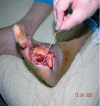Common foot examination features of 247 Iranian patients with diabetes
- PMID: 19432661
- PMCID: PMC7951794
- DOI: 10.1111/j.1742-481X.2009.00583.x
Common foot examination features of 247 Iranian patients with diabetes
Abstract
Background: Iran is a Middle Eastern country with a 70 million population. There are 3 million Iranians with diabetes mellitus (DM) and there is a high incidence of non traumatic amputation in this population. Amputation is often preceded by foot deformity or ulceration. We evaluated the routine foot examination of persons with diabetes (PWD) attending an outpatient Diabetic Clinic to identify the clinical characteristics that might be early warning signs of individuals at a high risk of developing a foot ulcer or having a subsequent non traumatic amputation.
Methods: A prospective, descriptive, clinic-based study was conducted on 247 patients with diabetes mellitus in 2005. The objectives of the study were to define the abnormal features of the foot examination in PWD which could be risk factors for ulceration or amputation.
Results: The mean age of patients with diabetes was 52 +/- 12. The prevalence of callus in the enrolled patients was 12% and heel fissures were noted in 50%. There was a significant relationship between callus formation and the absence of tibialis posterior pulse (odds ratio 5), the presence of the hammer toe deformity (odds ratio 4), and foot ulceration (odds ratio 3). The prevalence of foot ulcers in PWD was 4%.
Conclusion: A diabetic screening program identifying callus formation, absent pulses, and hammer toe are important early signs of individuals at an increased risk for foot ulcers. This program will facilitate early treatment to decrease the loss of limbs.
Figures
Similar articles
-
The association between callus formation, high pressures and neuropathy in diabetic foot ulceration.Diabet Med. 1996 Nov;13(11):979-82. doi: 10.1002/(SICI)1096-9136(199611)13:11<979::AID-DIA267>3.0.CO;2-A. Diabet Med. 1996. PMID: 8946157
-
Diabetic neuropathy, foot ulceration, peripheral vascular disease and potential risk factors among patients with diabetes in Bahrain: a nationwide primary care diabetes clinic-based study.Ann Saudi Med. 2007 Jan-Feb;27(1):25-31. doi: 10.5144/0256-4947.2007.25. Ann Saudi Med. 2007. PMID: 17277500 Free PMC article.
-
The prevalence of neuropathic foot ulceration in Sri Lankan diabetic patients.Ceylon Med J. 1996 Sep;41(3):96-8. Ceylon Med J. 1996. PMID: 8917968
-
Pathogenesis and Treatment of Callus in the Diabetic Foot.Curr Diabetes Rev. 2016;12(3):179-83. doi: 10.2174/1573399811666150609160219. Curr Diabetes Rev. 2016. PMID: 26054651 Review.
-
Prevalence of foot pathology and lower extremity complications in a diabetic outpatient clinic.J Rehabil Res Dev. 1989 Summer;26(3):35-44. J Rehabil Res Dev. 1989. PMID: 2666642 Review.
Cited by
-
Risk factors for ulceration and amputation in diabetic foot: study in a cohort of 496 patients.Endocrine. 2013 Aug;44(1):119-24. doi: 10.1007/s12020-012-9829-2. Epub 2012 Nov 3. Endocrine. 2013. PMID: 23124278
-
Frequency of foot ulcers in people with type 2 diabetes, presenting to specialist diabetes clinic at a Tertiary Care Hospital, Lahore, Pakistan.BMC Endocr Disord. 2018 Aug 6;18(1):53. doi: 10.1186/s12902-018-0282-y. BMC Endocr Disord. 2018. PMID: 30081878 Free PMC article.
-
Diabetic foot: infections and outcomes in Iranian admitted patients.Jundishapur J Microbiol. 2014 Jul;7(7):e11680. doi: 10.5812/jjm.11680. Epub 2014 Jul 1. Jundishapur J Microbiol. 2014. PMID: 25368803 Free PMC article.
-
Prevalence and associated factors of foot deformity among adult diabetic patients on follow-up at Debre Markos comprehensive specialized hospital, Northwest Ethiopia, 2022, cross-sectional study.BMC Endocr Disord. 2023 Nov 30;23(1):265. doi: 10.1186/s12902-023-01519-8. BMC Endocr Disord. 2023. PMID: 38037014 Free PMC article.
-
Characterising the biophysical properties of normal and hyperkeratotic foot skin.J Foot Ankle Res. 2015 Aug 12;8:35. doi: 10.1186/s13047-015-0092-7. eCollection 2015. J Foot Ankle Res. 2015. PMID: 26269720 Free PMC article.
References
-
- Inlow S, Orsted H, Sibbald RG. Best practices for the prevention, Diagnosis and treatment of diabetic foot ulcers. Ostomy Wound Manage 2000;46:55–68. - PubMed
-
- International Diabetes Federation. Diabetes Atlas available athttp://idf.firstserved.net/staging/atlas.html.
-
- Eldor R, Raz I, Yehuda AB, Boulton JM. New and experimental approaches to treatment of diabetic foot ulcers: a comprehensive review of emerging treatment strategies. Diabet Med 2004;21:1161–73. - PubMed
-
- Jeffcoate WJ, Harding KG. Diabetic foot ulcers. Lancet 2003;361:1545–51. - PubMed
-
- Boulton A, Vileikyte L, Tennvall GR, Apelquit J. The global burden of diabetic foot disease. Lancet 2005;366:1719–24. - PubMed
MeSH terms
LinkOut - more resources
Full Text Sources
Medical




